Senior Staff Writer Ruby Mustill interviews Emma Gometz, who makes good comics but still enjoys bad ones.
Bwog: First of all, would you mind introducing yourself and what you draw?
Emma Gometz: My name’s Emma Gometz, and I draw comics. I draw diary comics, I’ve drawn comic strips for various newspapers, and I guess I do professional illustrations, too. I’ve done illustrations for podcasts, theaters, and I’ve done illustrations for myself that are, like, self-expression single images. I mostly make artwork that’s about the perception of the self—especially myself, body image, and the tension between existing as a mental and physical being [laughs]. Or at least that’s what I think about a lot and I feel like it comes out in my artwork. But a lot of them are jokey jokes too.
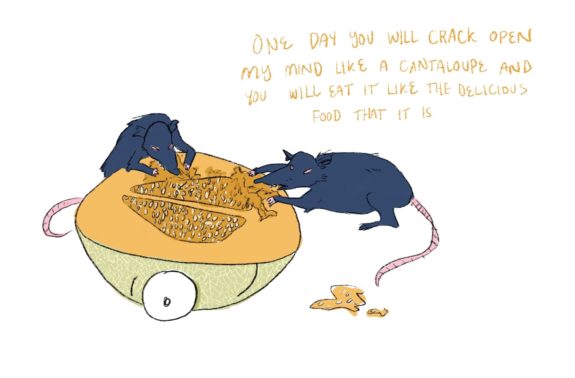
Is there a difference between being a cartoonist and being a comic artist?
Oh, I love that question. I think that you can be both a cartoonist and a comic artist, and I guess a cartoonist can be a comic artist. Both are narrative-based, but if you’re asking me personally, I see comic artists as more interested in longform narrative, and cartoonists as anyone who makes cartoon-y illustrations, however long.
Do you see yourself as more of one or the other?
I want to be a comic artist, but I’ve been making more cartoons lately. I used to be super into sequential paneling, and I still am, but I haven’t taken on those projects recently because they’re a huge commitment.
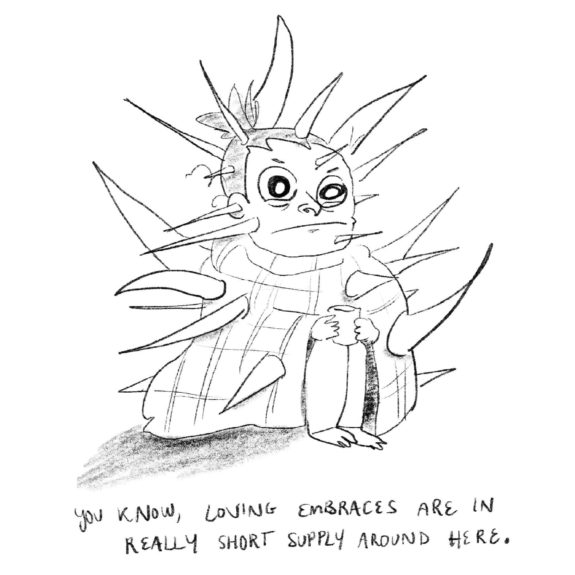
Why did you start drawing?
This is going to sound so ridiculous—but this is for a Columbia publication, so maybe people will relate—but because I was bored in class [laughs]. But also because I loved comics! Like, I read the newspaper as a kid for the comics. And I started to see how, in little pieces, you can describe small parts of a person’s world. You can choose how long you want the story to go—it doesn’t have to be a grand epic—it can be little moments that put together a larger world, however you want that to be. And I really like that. So I used to draw comics of moments and funny things that happened to me during class, about class. During school, about people. Especially because I like to observe people, and you can’t just go up to a person and be like, “I noticed this about you.” But if you make a comic about it, it can be perceived as flattering.
What comic strips did you read as a kid?
I really loved Calvin and Hobbes. And lots of non-cartoonists love Calvin and Hobbes, but that was probably my number one. I really liked Dilbert? As a child who didn’t work in an office? I liked that Dilbert was surreal, and it had a talking dog in it, and it was about something extremely mundane. I really liked this comic called Baby Blues. It was about a mother and a father raising two young kids, and it went on for so long that if you bought the anthologies, you could watch the kids grow up. I liked every comic strip that was in the New York Post from the years 2010 to 2013 [laughs]. And if you’re talking about influences, I started reading manga and watching anime once I was in high school. Especially because design is a little bit more carefully attended to in manga and anime.
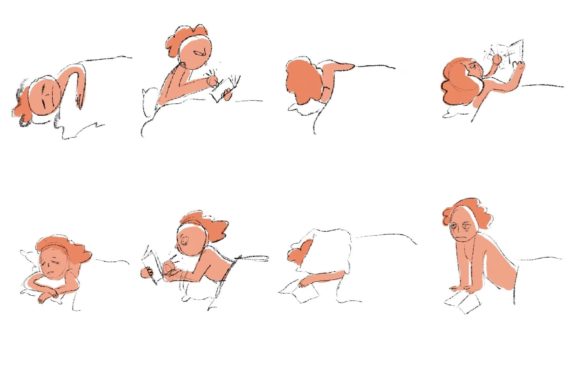
Do you still read those nowadays, or has your taste changed?
No, it’s totally changed. Now I read graphic novelists’ work and illustrators’ work. I really like Adrian Tomine, Jillian Tamaki, Liana Finck. I do read New Yorker cartoons, I like New Yorker cartoons, but I also like new, kind of offbeat graphic novels. And I love that the comics community is still flourishing. This guy named Luke Healy is making a graphic novel I’m really excited about right now. I just got Dog Biscuits by Alex Graham, which I love. So I’m just reading a lot of indie graphic novels and a lot of memoirs [laughs]. Oh, Sophie Yanow is another one I really like.
You mentioned that a lot of your work is like an illustrated diary, but you also post your comics on Instagram. Is it weird having an audience for your personal thoughts?
Unfortunately, I wish it were easier to make my thoughts more known to other people [laughs]. So it’s not weird, it’s preferred, which totally says something about me—and you can interpret that however you want. I think it has to do with my instinct as someone who has always wanted to be a performer. It’s not necessarily the act of performance that I want to do; it’s the act of putting a speaker to the way you think about things and how you synthesize the world. So I really enjoy letting people in on that.
I guess I just like to share things with people in a way that I can control. When I’m talking to people, there’s this sense of, “I’m not going to correctly describe what’s going on with me.” So comics and illustrations are the way I feel most comfortable describing what’s going on, because I don’t feel that conversations are sufficient sometimes. My work is almost like a diary of how I’ve understood the world and myself over time.
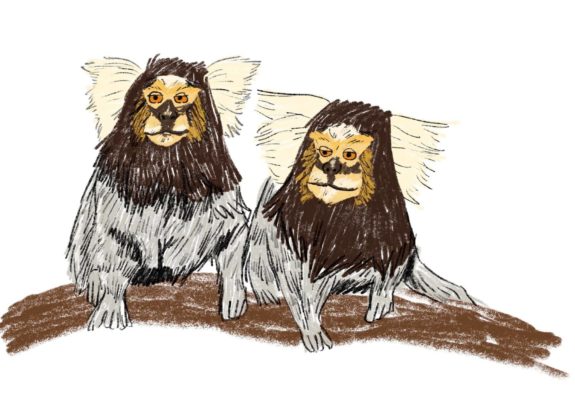
I scrolled back to your first Instagram post. Your caption was about how you put off making the account for months, but finally decided you needed to do it. Why did you put it off, and why did you ultimately go through with it?
Well, I guess I was concerned about the audience thing. Like, I had previously related to comics by drawing comics about people I knew for people I knew, and it was nice to get an in-person reaction. I never perceived them as like, “content,” or as public entertainment—but I was starting to follow people who saw comics that way. I really admired them, and I was like, “Wow, if comics can do this for me, I feel like I should join these people as a peer.”
So I decided to do it because I started to see myself as a member of the comics community, and I wanted to contribute. I was like, “No longer shall I keep these things to myself. I think that they’re worth sharing.” With that, what was so scary was that it opened me up to criticism. It opened me up to, “Should I be looking for more likes? Should I be looking for more engagement? Do I want to make money doing this? Do I want to make this part of my brand?” And that was really scary too, and that’s something I’m still struggling with right now.
Why did you feel that comics were something you needed to do?
Because I really love comics, and I really love making them. I think I have a unique perspective, and when I look at my artwork, I’m like, “I’m glad that I’m making this.” I just think, “Why not me? Why not try to put it out there?”
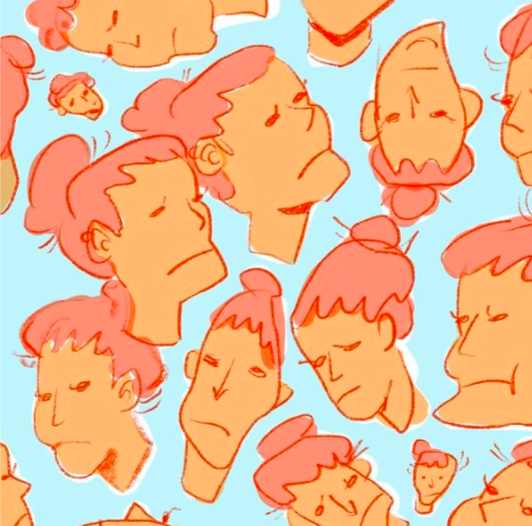
Since you’ve started posting your work, have you gotten any criticism?
Mostly from my parents [laughs]. I’ve gotten compliments too, from people I don’t know, which is cool. The nicest compliment anyone’s ever given me was after Alex Graham, who wrote Dog Biscuits, shared the Instagram handles of a lot of people she admired. I followed a couple of those people, and all of them followed me back. One who I particularly liked sent me a message saying, “I really love your stuff.” She shared my work on her page, and I was like, “That’s so cool.” It felt really awesome.
My parents like my comics, but they don’t really believe in being genuine about negative feelings. A lot of what I’ve been making recently has been in more of a negative space than usual—because of the pandemic, because of life transitions, and because I’m trying to think more about body image in my work.
Honestly, I feel like I’ve gotten way more criticism on other forms of art that I’ve made, like playwriting. Comics feel like a safe space for me, because there are a lot of bad comics, and even bad comics are fun to look at. Bad plays? Unbearable. Bad comedy? Unbearable. But bad comics are like “Ooh, this is garage, this is indie, this is a zine.”
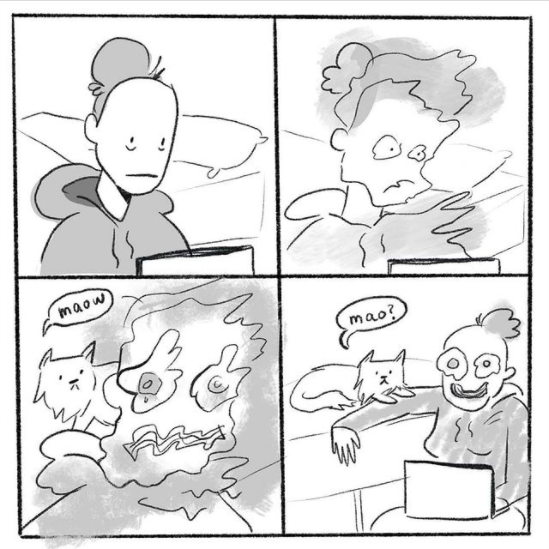
How would you describe your process? Do you draw by hand or digitally?
I love to do things by hand. I haven’t done a lot of things by hand lately because I don’t have the time for it. Usually, I’ll just start by having an idea, and being like, “I need to turn this into a comic.” I’ll either be intentionally brainstorming for something like the Spectator comic strips, or I’ll just have something come up in my head, and I’ll be like, “This is kind of funny, it should be a comic.” And then I’ll just sketch out a draft of it. If I want it to be posted that day, I’ll do it on the iPad. But if the artistic style of it is really important to me, then I’ll do it by hand. And then I do the line art, and then I do the shading, and then I always send it to Nic [my boyfriend] because he has a good eye for anything that’s not quite right. I know that something is really good if he really likes it.
Do you want people to feel or think more when they look at your work?
Love that. I remember reading Isobel’s answer to that. I want people to feel more when they look at my work. I’m not going to make any—I mean, maybe someday I’ll make a really layered argument-slash-observation that I want people to put on their syllabi, or whatever. But right now I think I’m just focused on making people laugh and feel seen.
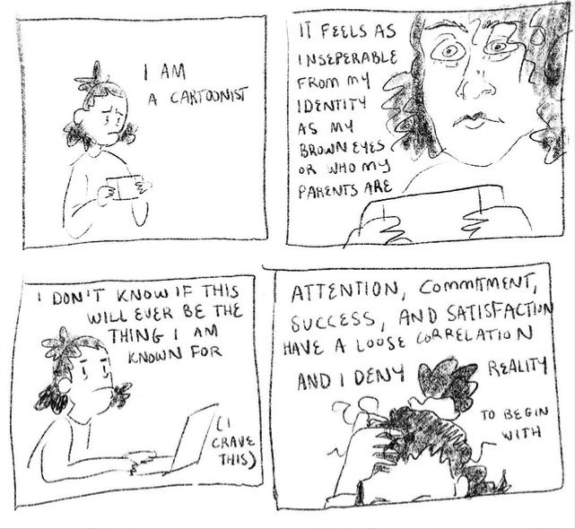
You can view more of Emma’s work on Instagram. This interview has been edited for length and clarity.
Comics courtesy of Emma Gometz


 4 Comments
4 Comments
4 Comments
@Anonymous 1. this is cool as hell
2. i’ve wanted to do this for years but i can’t draw for shit and ryan north already took my clipart idea back in 2005
@Anonymous This was an amazing read and i loved learning more about emma’s mind and process :)) You’re SO COOOOOOL AHHH i love you work :)
@Anonymous Emma! Just want to say that you’re an absolute shining gem of a human being and I totally Iook up to you. Big things are coming your way, I can feel it :) Happy graduation, and thanks for making Columbia that much brighter.
@Anonymous Coool.